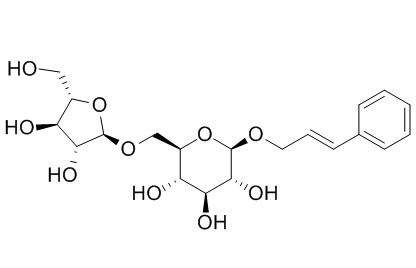Rosarin
Rosarin is a natural product from Rhodiola rosea L.
Inquire / Order:
manager@chemfaces.com
Technical Inquiries:
service@chemfaces.com
Tel:
+86-27-84237783
Fax:
+86-27-84254680
Address:
1 Building, No. 83, CheCheng Rd., Wuhan Economic and Technological Development Zone, Wuhan, Hubei 430056, PRC
Providing storage is as stated on the product vial and the vial is kept tightly sealed, the product can be stored for up to
24 months(2-8C).
Wherever possible, you should prepare and use solutions on the same day. However, if you need to make up stock solutions in advance, we recommend that you store the solution as aliquots in tightly sealed vials at -20C. Generally, these will be useable for up to two weeks. Before use, and prior to opening the vial we recommend that you allow your product to equilibrate to room temperature for at least 1 hour.
Need more advice on solubility, usage and handling? Please email to: service@chemfaces.com
The packaging of the product may have turned upside down during transportation, resulting in the natural compounds adhering to the neck or cap of the vial. take the vial out of its packaging and gently shake to let the compounds fall to the bottom of the vial. for liquid products, centrifuge at 200-500 RPM to gather the liquid at the bottom of the vial. try to avoid loss or contamination during handling.
Neuropharmacology.2018, 131:68-82
J. Soc. Cosmet. Sci. Korea2021, 47(1):57-63
Korean Journal of Pharmacognosy.2015, 46(4):352-364
Molecules.2019, 24(23):E4303
Anticancer Res.2024, 44(3):1033-1044.
J Plant Biotechnol.2023, 50:070-075.
Int. J. of Food Properties2017, S108-S118
Mol Plant Pathol.2023, 24(2):123-141.
Research Square2024, rs-4398438
Journal of Ginseng Research2023, 12.004.
Related and Featured Products
Evid Based Complement Alternat Med. 2013;2013:514049.
Anti-Inflammatory and Neuroprotective Effects of Constituents Isolated from Rhodiola rosea.[Pubmed:
23690847]
METHODS AND RESULTS:
To determine the biological activity of Rhodiola rosea, the protein expression of iNOS and proinflammatory cytokines was measured after the activation of murine microglial BV2 cells by LPS under the exposure of constituents of Rhodiola rosea: crude extract, rosin, Rosarin, and salidroside (each 1-50 μ g/mL). The LPS-induced expression of iNOS and cytokines in BV2 cells was suppressed by the constituents of Rhodiola rosea in a concentration-dependent manner. Also the expression of the proinflammatory factors iNOS, IL-1 β , and TNF- α in the kidney and prefrontal cortex of brain in mice was suppressed by the oral administration of Rhodiola rosea crude extract (500 mg/kg). To determine the neuroprotective effect of constituents of Rhodiola rosea, neuronal cells were activated by L-glutamate, and neurotoxicity was analyzed. The L-glutamate-induced neurotoxicity was suppressed by the treatment with rosin but not by Rosarin. The level of phosphorylated MAPK, pJNK, and pp38 was increased by L-glutamate treatment but decreased by the treatment with rosin and salidroside.
CONCLUSIONS:
These results indicate that Rhodiola rosea may have therapeutic potential for the treatment of inflammation and neurodegenerative disease.



